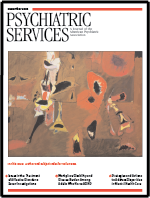Use of Health Care Services Among Persons Who Screen Positive for Bipolar Disorder
Abstract
OBJECTIVE: This study examined patterns of diagnosis, consultation, and treatment of persons who screened positive for bipolar disorder. METHODS: An impact survey was mailed to a representative subset of 3,059 individuals from a large U.S.-population-based study that utilized the Mood Disorder Questionnaire (MDQ). RESULTS: Respondents who screened positive on the MDQ (reported the presence of seven of 13 symptoms of bipolar disorder, the co-occurrence of at least two symptoms, and moderate or severe symptom-related impairment) (N=1,167) had consulted a health care provider more often in the previous year than those who screened negative (reported six or fewer symptoms regardless of symptom co-occurrence or impairment) (N=1,283). Psychiatrists and primary care physicians failed to detect or misdiagnosed bipolar disorder among 53 percent and 78 percent of patients, respectively, who screened positive for bipolar disorder. The most commonly used psychotropic medications during the previous 12 months among those who screened positive were antidepressants alone (32 percent), followed by lithium and anticonvulsant mood stabilizers (20 percent), antidepressants in combination with other psychotropics (19 percent), hypnotics (19 percent), and antipsychotics (9 percent). In the preceding 12 months, respondents who screened positive on the MDQ had greater use of psychiatric hospitals, emergency departments, and urgent care centers and also had more outpatient visits to primary care physicians, psychiatrists, and alcohol treatment centers than those who screened negative. CONCLUSIONS: The results of this study suggest that bipolar disorder is an underdiagnosed and often inappropriately treated illness associated with significant use of health care resources.



